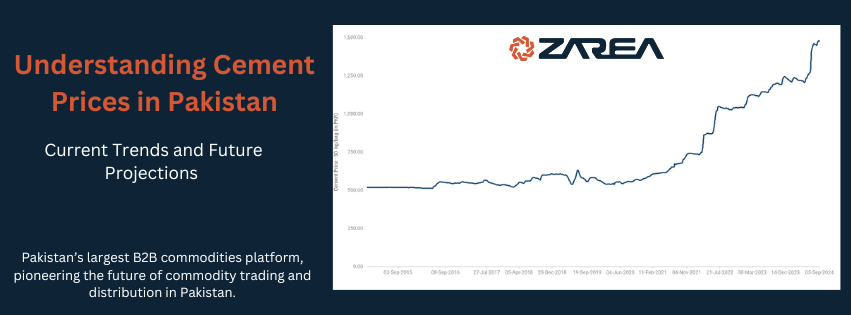
The cement industry in Pakistan plays a critical role in the country’s economy, serving as the backbone for infrastructure development and urbanization. Over the years, cement prices have been a topic of interest, particularly for builders, investors, and the construction sector. In 2024, cement prices have fluctuated due to various factors such as demand and supply dynamics, inflation, fuel costs, and government policies. This blog aims to provide an in-depth analysis of the current cement price trends in Pakistan and offers insights into what the future may hold for this essential building material.
Current Cement Price Trends in Pakistan
As of 2024, cement prices in Pakistan range between PKR 1,470 and PKR 1,550 per 50kg bag, depending on the region and the manufacturer. These prices have experienced a slight increase over the past year due to several factors:
- Rising Raw Material Costs: The raw materials used in cement production, such as limestone, clay, and gypsum, have seen price hikes due to inflation and supply chain disruptions. The global rise in fuel prices, particularly coal, which is a critical component in cement production, has also contributed to the upward pressure on cement prices.
- Increased Demand for Infrastructure Projects: The demand for cement has been bolstered by the government’s ambitious infrastructure projects, including road networks, housing schemes, and dams. As Pakistan pushes forward with its development plans, the demand for construction materials, particularly cement, has risen, further influencing prices.
- Devaluation of the Pakistani Rupee: The ongoing devaluation of the Pakistani rupee against major currencies has led to increased import costs for raw materials and fuel. This devaluation makes cement production more expensive, translating into higher prices for consumers
- Energy Costs: Cement manufacturing is an energy-intensive process, and the rising cost of electricity and fuel has had a direct impact on production costs. As energy prices continue to soar, cement manufacturers have been forced to pass these costs onto the consumers.
Regional Disparities in Cement Prices
Cement prices in Pakistan vary from region to region. Urban areas like Karachi, Lahore, and Islamabad typically see higher prices due to transportation costs, market demand, and availability. In contrast, rural areas tend to have slightly lower prices, though accessibility can be an issue. Additionally, the type of cement — whether it’s Ordinary Portland Cement (OPC) or Sulfate Resistant Cement (SRC) — also affects the price. OPC is generally more commonly used and slightly cheaper than SRC, which is used in specialized construction projects that require higher durability.
For those looking for a reliable source of construction materials, Zarea Limited offers a wide range of cement brands and ensures prompt delivery to your location, making it a trusted partner in the construction industry.
Factors Influencing Future Cement Prices in Pakistan
The future of cement prices in Pakistan is influenced by both domestic and international factors. Below are some key drivers that could shape the pricing landscape in the coming years:
- Global Coal Prices: Since coal is a primary fuel used in cement production, any fluctuations in global coal prices will directly impact cement prices. If coal prices continue to rise, cement prices will likely follow suit. Conversely, if energy sources shift towards more sustainable options, we may see stabilization or even a decrease in production costs.
- Economic Policies: The government’s monetary and fiscal policies, especially regarding taxation and subsidies in the energy sector, will have a significant impact on the cement industry. If favorable policies are introduced, such as subsidies for raw materials or energy costs, cement prices could stabilize or decrease. On the other hand, if taxes and levies increase, we may see further price hikes.
- Technological Advancements: Innovations in cement production technology, such as alternative fuels and more energy-efficient manufacturing processes, could lead to cost reductions in the long run. Some manufacturers are already exploring renewable energy sources like solar and wind to reduce their reliance on expensive fossil fuels.
- Infrastructure Growth: With Pakistan’s growing urban population and government’s focus on infrastructure, the demand for cement is likely to stay high. While increased demand often results in price surges, the entry of more players into the market or expanded production capacity could help offset price hikes.
- Environmental Regulations: With a growing emphasis on sustainable construction and reduced carbon emissions, the cement industry is under pressure to adopt greener practices. This shift towards eco-friendly production, while crucial for the environment, may also lead to increased costs if companies have to invest in new technologies or carbon credits.

Future Outlook for Cement Prices
Looking ahead, it is likely that cement prices in Pakistan will remain volatile in the short to medium term. The global energy crisis, rising inflation, and unpredictable geopolitical tensions will continue to play a pivotal role in determining production costs. However, if local producers adopt energy-efficient practices and alternative fuel sources, there is hope for price stabilization in the long run.
In the next few years, Pakistan’s cement industry may also see a surge in exports, which could further influence local prices. Currently, Pakistan exports cement to neighboring countries like Afghanistan and Sri Lanka. If demand from these markets increases, local prices could be affected as manufacturers prioritize exports over domestic supply.
Moreover, competition among manufacturers is expected to intensify, especially with the entry of new players into the market. This could bring about more competitive pricing strategies, which would benefit consumers. Zarea Limited is well-positioned in this competitive market, offering a wide range of cement options to cater to diverse construction needs. Their commitment to quality and customer service makes them a reliable partner for both small and large-scale projects.
Conclusion
Cement prices in Pakistan are influenced by a complex set of factors, from global fuel costs to local economic policies and environmental regulations. As we move forward into 2024 and beyond, the industry will face challenges but also opportunities for innovation and growth. For construction companies, contractors, and even individual consumers, keeping a close eye on market trends and understanding the factors driving price changes is essential for making informed purchasing decisions.
To stay updated on the latest cement prices and ensure you’re getting the best value for your projects, consider partnering with Zarea Limited. Their comprehensive range of cement products, along with their commitment to timely delivery and competitive pricing, makes them the go-to source for all your construction material needs.

